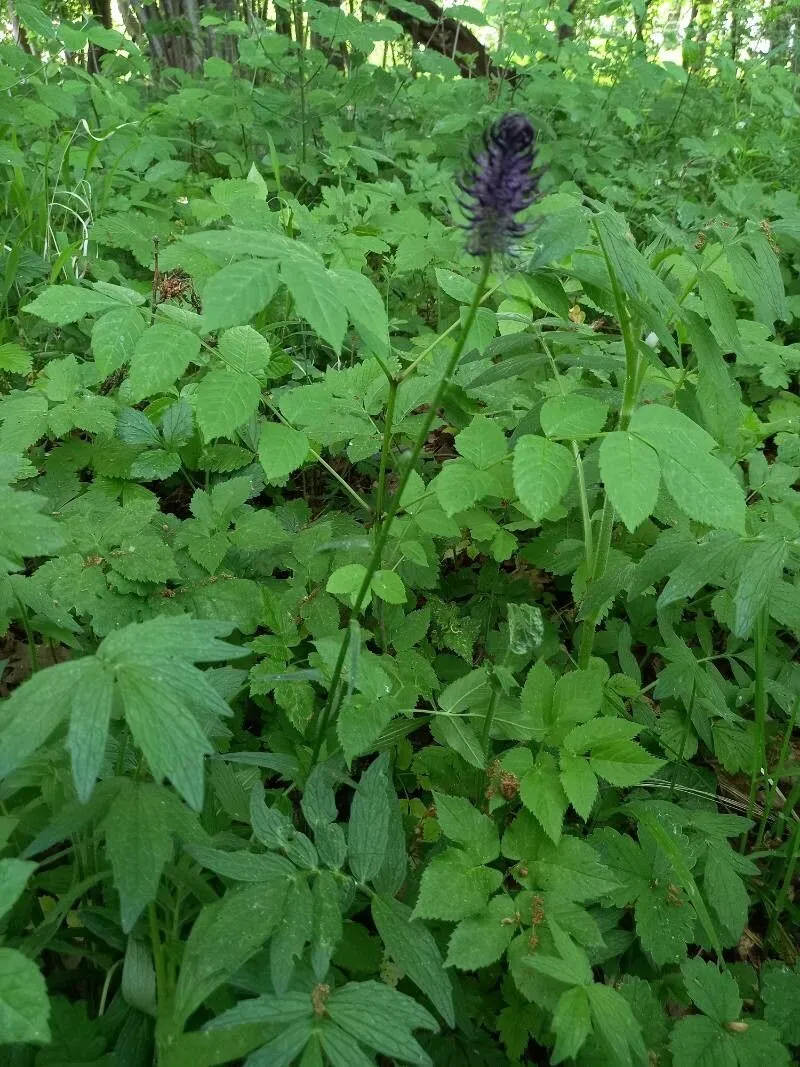
Author: F.W.Schmidt
Bibliography: Fl. Boëm. 2: 87 (1793 publ. 1794)
Year: 1794
Status: accepted
Rank: species
Genus: Phyteuma
Vegetable: False
Observations: Belgium to Austria, C. Belarus
Black rampion, scientifically known as Phyteuma nigrum, is a captivating plant species that shares its heritage with the Campanulaceae family. This plant graces a broad region, making its presence felt from Belgium all the way to Austria and Central Belarus.
The first formal description of Black rampion dates back to the late 18th century, more specifically to the year 1793 (published in 1794), when botanist F.W. Schmidt included it in his comprehensive botanical work “Flora Boëmica” (Fl. Boëm. 2: 87).
Phyteuma nigrum showcases a unique morphology that’s both striking and unusual. Known for its elongated inflorescence, the plant bears tightly clustered flowers that form a dense, spike-like arrangement. This characteristic inflorescence, combined with the plant’s rich dark hue, lends it an elegant and distinctive appearance, making it an attractive addition to natural landscapes.
In terms of habitat, Black rampion thrives in a variety of environments across its geographical range. It can be found gracing meadows, forest clearings, and grasslands. The plant’s adaptability to different soil types and climatic conditions contributes to its wide distribution across Europe.
As part of the Campanulaceae family, Black rampion shares several traits with its relatives. Members of this family are generally known for their bell-shaped flowers and herbaceous growth forms. Despite these similarities, Phyteuma nigrum distinguishes itself with its unique floral arrangement and coloration.
Exploring the distribution pattern of Black rampion is fascinating for botanists and plant enthusiasts alike. The plant’s presence from Belgium to Austria as well as Central Belarus offers valuable insights into its ecological preferences and adaptability to varying climates and terrains.
In conclusion, Black rampion (Phyteuma nigrum) stands out as a remarkable species within the Campanulaceae family, celebrated for its distinct and elegant inflorescence, broad geographical distribution, and historical botanical significance. Its beauty and resilience continue to captivate and inspire those who study and appreciate the rich diversity of the plant kingdom.
Swe: blekgul daglilja, spansknäva, blårapunkel, brunröd daglilja, klibbnäva, tummatähkämunkki
Dan: blå rapunsel, rundbladet storkenæb, rødgul daglije, spansk storkenæb
Deu: schwarze teufelskralle
Nno: svartvadderot
Nob: svartvadderot
Fin: tummatähkämunkki
Eng: black rampion, black
Nld: zwartblauwe rapunzel
En: Black Rampion, Black, Black-horned Rampion
Da: Blå rapunsel, Rundbladet storkenæb, Rødgul daglije, Spansk storkenæb
Nl: Zwartblauwe rapunzel, Zwarte Rapunzel
Fi: Tummatähkämunkki
Fr: Raiponce bleue, Raiponce noire
De: Schwarze Teufelskralle, Schwarze Rapunzel, Schwarzer Rapunzel
It: Raponzolo nero
Nb: Svartvadderot
Nn: Svartvadderot
Sv: Blekgul daglilja, Spansknäva, Blårapunkel, Brunröd daglilja, Klibbnäva, Tummatähkämunkki
: Black rampion
Taken May 13, 2022 by Kai Best (cc-by-sa)
Taken May 7, 2020 by Lisa Brünjes (cc-by-sa)
Taken Jul 19, 2020 by Mieke d (cc-by-sa)
Taken Jul 23, 2019 by stefano1203 (cc-by-sa)
Taken May 24, 2019 by Hans van Schendel (cc-by-sa)
Taken May 13, 2022 by Kai Best (cc-by-sa)
Taken May 15, 2022 by Christof Weck (cc-by-sa)
Taken Jun 13, 2022 by Frank Sundermeyer (cc-by-sa)
Taken May 13, 2022 by Kai Best (cc-by-sa)
Taken May 7, 2020 by Lisa Brünjes (cc-by-sa)
Taken Jun 19, 2017 by Henk Van Lottum (cc-by-sa)
Taken Apr 25, 2014 by Tela Botanica − Hugues TINGUY (cc-by-sa)
Taken May 13, 2022 by Kai Best (cc-by-sa)
Taken May 13, 2022 by Kai Best (cc-by-sa)
Taken May 7, 2020 by Lisa Brünjes (cc-by-sa)
Taken May 15, 2014 by Photoflora – Benoit BOCK (©)
Taken May 25, 2022 by Patrick Nard (cc-by-sa)
Taken Jun 23, 2019 by Alain Lagrave (cc-by-sa)
Taken Jul 13, 2017 by ZŠ Štefcova (cc-by-sa)
Taken May 15, 2014 by Photoflora – Benoit BOCK (©)
Taken May 15, 2014 by Photoflora – Benoit BOCK (©)
Taken May 15, 2014 by Photoflora – Benoit BOCK (©)
© copyright of the Board of Trustees of the Royal Botanic Gardens, Kew.
© copyright of the Board of Trustees of the Royal Botanic Gardens, Kew.
Ph maximum: 7.5
Ph minimum: 7.0
Light: 6
Atmospheric humidity: 7
Soil nutriments: 5
Family: Myrtaceae Author: (F.Muell.) K.D.Hill & L.A.S.Johnson Bibliography: Telopea 6: 402 (1995) Year: 1995 Status:…
Family: Rubiaceae Author: Pierre ex A.Froehner Bibliography: Notizbl. Bot. Gart. Berlin-Dahlem 1: 237 (1897) Year:…
Family: Sapindaceae Author: Koidz. Bibliography: J. Coll. Sci. Imp. Univ. Tokyo 32(1): 38 (1911) Year:…
Family: Asteraceae Author: A.Gray Bibliography: Pacif. Railr. Rep.: 107 (1857) Year: 1857 Status: accepted Rank:…
Family: Fabaceae Author: Medik. Bibliography: Vorles. Churpfälz. Phys.-Ökon. Ges. 2: 398 (1787) Year: 1787 Status:…
Family: Aspleniaceae Author: (Cav.) Alston Bibliography: Bull. Misc. Inform. Kew 1932: 309 (1932) Year: 1932…